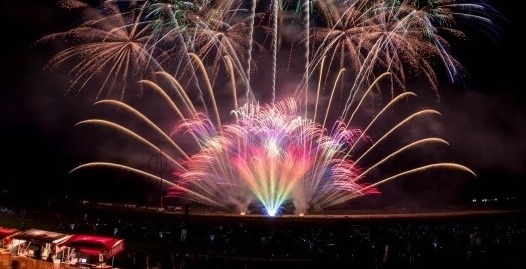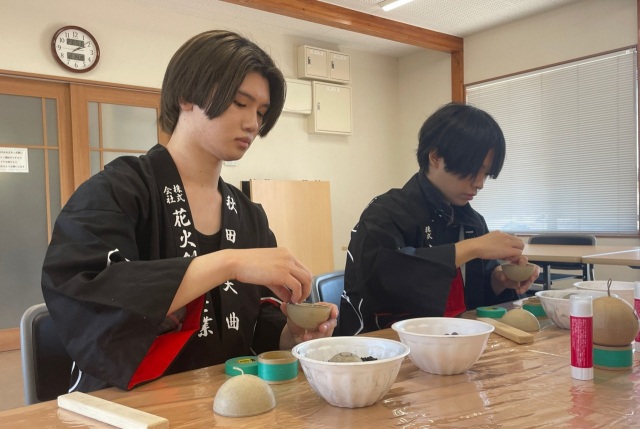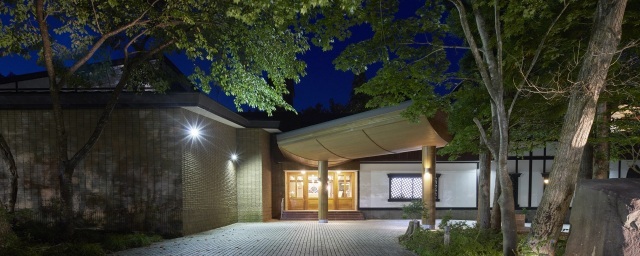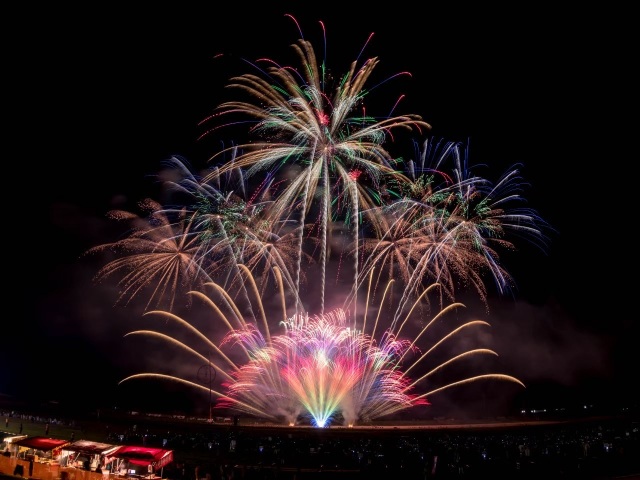Omagari fireworks crafting workshop and Tohoku cultural adventure

- Suggested Time : 2 days / 1 nights
- Transport Options : Drive
You’ll be impressed with the skill and creativity of the craftsmen of Omagari, a city of fireworks, and the private fireworks display will be a sight you will never forget.
START
Kakunodate Station (10:40)
Sightseeing in Kakunodate City (stroll around samurai residences), lunch of Okaribayaki(11:00-13:30)
Travel back in time to the Edo period in the “Little Kyoto of Tohoku”!

Kakunodate is a former castle town which flourished during the Edo period. Known as the “Little Kyoto of Tohoku”, the town is home to a district two-kilometres in radius consisting of samurai residences and traditional architecture popular with both domestic and international tourists. The samurai residences lining the town’s most famous street are nationally protected Traditional Buildings.
Though some of them are still functioning homes, the residences are open to the public so visitors can get a feel for the traditional samurai life. Tourists can travel back in time to the Edo period by strolling around the traditional streets in an antique Kimono from one of the rental stores in town! A rickshaw ride from the Kakunodate Denshokan Museum will enhance the experience.
The town is charming throughout the year with springtime cherry blossoms, verdant summer greens, colourful autumn leaves and snowy winter scenes. Springtime is particularly popular with people coming for cherry blossom viewing from late April to early May. The traditional district features a row of weeping cherry blossom trees whose pink flowers bloom in beautiful contrast with the black walls of samurai residences, 162 of the 400 weeping cherry trees are designated natural treasures.
The samurai district is a 15 to 20-minute walk from JR Kakunodate station. Be sure to pick up the handy map and brochures available at the tourist information centre, located in a building resembling a traditional storehouse in front of the station!
A thematic journey in the Tohoku region:Castles・SamuraiA thematic journey in the Tohoku region:Flowers
Though some of them are still functioning homes, the residences are open to the public so visitors can get a feel for the traditional samurai life. Tourists can travel back in time to the Edo period by strolling around the traditional streets in an antique Kimono from one of the rental stores in town! A rickshaw ride from the Kakunodate Denshokan Museum will enhance the experience.
The town is charming throughout the year with springtime cherry blossoms, verdant summer greens, colourful autumn leaves and snowy winter scenes. Springtime is particularly popular with people coming for cherry blossom viewing from late April to early May. The traditional district features a row of weeping cherry blossom trees whose pink flowers bloom in beautiful contrast with the black walls of samurai residences, 162 of the 400 weeping cherry trees are designated natural treasures.
The samurai district is a 15 to 20-minute walk from JR Kakunodate station. Be sure to pick up the handy map and brochures available at the tourist information centre, located in a building resembling a traditional storehouse in front of the station!
A thematic journey in the Tohoku region:Castles・SamuraiA thematic journey in the Tohoku region:Flowers
Okariba Yaki (Senboku City, Akita Prefecture)

Okariyaki is a dish of meat and seasonal vegetables cooked with Sansho miso.The flavor of the ingredients is enhanced by the fragrant Sansho miso, creating a bold yet delicate taste.It is a local dish full of historical romance that should be enjoyed while thinking of the Satake Kita family's wild pastimes.It is called “Okari-ba-yaki,” meaning “to grill and eat at the hunting place.
Fireworks Traditional Culture Succession Museum -Hanabi Amu (Daisen City, Akita Prefecture)
Knowing the other side of fireworks makes you love them more.

Visitors can learn more about the history of fireworks, the process of making fireworks, and the mechanism of fireworks, as well as enjoy a virtual fireworks shooting experience and a virtual factory tour using various visual devices.
The “Omagari Fireworks” (replica) by Seiji Fujishiro, a world-famous shadow puppet artist, installed on the third floor is a masterpiece.
Visitors to “Hanabi-AM” can experience all the charm of fireworks. Come here and you will love fireworks even more and enjoy them even more!
The “Omagari Fireworks” (replica) by Seiji Fujishiro, a world-famous shadow puppet artist, installed on the third floor is a masterpiece.
Visitors to “Hanabi-AM” can experience all the charm of fireworks. Come here and you will love fireworks even more and enjoy them even more!
Omagari fireworks craftsman workshop and private fireworks show (tour the fireworks factory and create a mockup fireworks shell) (15:00-16:30)
Get impressed by craftsman's technics and creativity in Oomagari, a town of fireworks! Private fireworks you see there will be a memory of your life.

Since 1910 (Meiji 43), Oomagari's fireworks has more than 110 years of history. Omagari Hanabi Artist will guide you in their factory, replica Shell Building experience and museum visit, that helps you to learn their history of fireworks. At the end of the program, you will see your original "private fireworks".You will have a premium experience of watching the best fireworks with a commentary of a Omagari Hanabi Artist.
Check-in and dinner at a hotel in Omagari City (18:00-19:30)

Private fireworks show(20:00-20:30)
Get impressed by craftsman's technics and creativity in Oomagari, a town of fireworks! Private fireworks you see there will be a memory of your life.

Since 1910 (Meiji 43), Oomagari's fireworks has more than 110 years of history. Omagari Hanabi Artist will guide you in their factory, replica Shell Building experience and museum visit, that helps you to learn their history of fireworks. At the end of the program, you will see your original "private fireworks".You will have a premium experience of watching the best fireworks with a commentary of a Omagari Hanabi Artist.
Stay one night at a hotel in Omagari City
Day2
Depart hotel (9:00)
Lake Tazawa / The Statue of Tatsuko
Get spiritual at Japan’s deepest lake with mysterious cobalt blue water!

Lake Tazawa (Tazawako) is a stunning lake in Akita and has been selected as one of the 100 most scenic spots in Japan.
It is the deepest lake in Japan, with a depth of 423.4 meters. The surface of the lake changes from brilliant lapis lazuli to azure to indigo and is worth seeing. Take a cruise on a sightseeing boat, or take a paddle boat, canoe, kayak, SUP to enjoy the waters of the lake. It is also worth cycling, trekking, or driving along the lakeside to see the colors change across the lake. For those who want to stay longer, set up camp and see the changes with the time of day.
The Statue of Tatsuko is a golden female statue which stands against the backdrop of this magnificent lake. It is a famous spot by Lake Tazawa erected based on a legend that once upon a time, a girl named Tatsuko, who wished to keep her beauty forever, turned into a dragon and threw herself into Lake Tazawa. But there is more to this legend. In Hachirogata, or Hachiro Lagoon, there was a man named Hachiro Taro transformed into a dragon, and he fell in love with Tatsuko. As the two began to live together in Lake Tazawa, the lake became deeper and deeper without freezing in winter. In contrast, Hachiro Lagoon became shallower and shallower with each passing year when its master disappeared.
There are three statues associated with the Tatsuko Legend; the others being Tatsuko Kannon on the east shore of the lake and Tatsuko Hime (Princess Tatsuko) on the grounds of the Gozanoishi Shrine. Ukiki Shrine, located right next to the Statue of Tatsuko, is a power spot for marriage. Gozanoishi Shrine, which enshrines Tatsuko Hime no Kami as its main deity, is said to be bring beauty. The red torii gate is a popular photo spot.
It is the deepest lake in Japan, with a depth of 423.4 meters. The surface of the lake changes from brilliant lapis lazuli to azure to indigo and is worth seeing. Take a cruise on a sightseeing boat, or take a paddle boat, canoe, kayak, SUP to enjoy the waters of the lake. It is also worth cycling, trekking, or driving along the lakeside to see the colors change across the lake. For those who want to stay longer, set up camp and see the changes with the time of day.
The Statue of Tatsuko is a golden female statue which stands against the backdrop of this magnificent lake. It is a famous spot by Lake Tazawa erected based on a legend that once upon a time, a girl named Tatsuko, who wished to keep her beauty forever, turned into a dragon and threw herself into Lake Tazawa. But there is more to this legend. In Hachirogata, or Hachiro Lagoon, there was a man named Hachiro Taro transformed into a dragon, and he fell in love with Tatsuko. As the two began to live together in Lake Tazawa, the lake became deeper and deeper without freezing in winter. In contrast, Hachiro Lagoon became shallower and shallower with each passing year when its master disappeared.
There are three statues associated with the Tatsuko Legend; the others being Tatsuko Kannon on the east shore of the lake and Tatsuko Hime (Princess Tatsuko) on the grounds of the Gozanoishi Shrine. Ukiki Shrine, located right next to the Statue of Tatsuko, is a power spot for marriage. Gozanoishi Shrine, which enshrines Tatsuko Hime no Kami as its main deity, is said to be bring beauty. The red torii gate is a popular photo spot.
Lake Tazawa (see the statue of Tatsuko), lunch at ORAE Restaurant and Brewery by the lake (10:00-13:00)
A restaurant where you can enjoy home-brewed beer and local food

Enjoy European-style cuisine and home-brewed beer made with fresh local vegetables from Lake Tazawa in Akita, Japan,The restaurant offers a variety of dishes made with fresh local vegetables from Lake Tazawa in Akita, as well as beer brewed in the brewery.
Morioka City sightseeing / Morioka Hachimangu Shrine (14:00-14:40)
The 300-year history of the castle town of Morioka

Morioka Hachimangu Shrine was built in 1680 by the 29th feudal lord Shigenobu Nanbu. The god enshrined here has been revered by the locals since ancient times as the god for the roots of human life which include farming, industry, commerce, learning and the other basics of life.
The shrine has been repeatedly rebuilt over the years after disasters such as the Morioka fire of 1884 and from damage from wind and snow. The current shrine was rebuilt as Shin-Hachimangu Shrine in 1997. The bright red Taisha shrine with brilliant carvings has a dignified presence as the new face of Morioka.
As the largest shrine in the prefecture and as a base for religion and celebrations rooted in people's lives, it is crowded even today with many worshipers throughout the year.In addition to being the most-crowded shrine in the prefecture in the New Year for hatsumode, it also hosts Donto Festival and Hadaka-mairi on 15 January and the Setsubun Festival and Fire Prevention Festival on 3 February. In addition, the Annual Autumn Festival of the Morioka Hachiman Shrine, held from 14 to 16 September, features many floats and overflows with crowds enjoying the festival.
The shrine has been repeatedly rebuilt over the years after disasters such as the Morioka fire of 1884 and from damage from wind and snow. The current shrine was rebuilt as Shin-Hachimangu Shrine in 1997. The bright red Taisha shrine with brilliant carvings has a dignified presence as the new face of Morioka.
As the largest shrine in the prefecture and as a base for religion and celebrations rooted in people's lives, it is crowded even today with many worshipers throughout the year.In addition to being the most-crowded shrine in the prefecture in the New Year for hatsumode, it also hosts Donto Festival and Hadaka-mairi on 15 January and the Setsubun Festival and Fire Prevention Festival on 3 February. In addition, the Annual Autumn Festival of the Morioka Hachiman Shrine, held from 14 to 16 September, features many floats and overflows with crowds enjoying the festival.
Morioka Castle Ruins Park (14:50-15:30)
The well-preserved stone walls are a must see. Enjoy year-round seasonal beauty in this castle ruins park!

A 15-minute walk from Morioka station takes you to Morioka Castle, officially recognised as a national historic site and one of Japan’s top 100 castles.
When constructed in 1597 the castle was originally known as Kozukata Castle. It was the residence of the local feudal lords until 1874 when most of the buildings were demolished. Fortunately the stone walls remain in their original form and the castle grounds were preserved as a park in 1906.
Today the park is known as Morioka Castle Ruins Park and is a popular place for relaxation and recreation for locals. It is also recognised as one of Japan’s 100 best historical parks.
Many people come to the park during the springtime Sakura Festival. The view of cherry blossoms is enchanting when illuminated by paper lanterns at night. The park attracts visitors throughout the year with its seasonal beauty. Tsurugaike Pond is gracefully decorated with blooming wisteria trellises in May and hydrangeas in July. Scarlet maple leaves and vivid yellow gingko leaves are gorgeous in contrast with the castle’s stone walls in autumn. A large number of miniature snow huts create fascinating scenes when candlelit during Morioka Yukiakari Festival in winter.
The park is also home to monuments of some of the great names in literature including Takuboku Ishikawa, Kenji Miyazawa and Inazo Nitobe. Some of the works of each are inscribed on the monuments.
A thematic journey in the Tohoku region:Castles・SamuraiA thematic journey in the Tohoku region:Flowers
When constructed in 1597 the castle was originally known as Kozukata Castle. It was the residence of the local feudal lords until 1874 when most of the buildings were demolished. Fortunately the stone walls remain in their original form and the castle grounds were preserved as a park in 1906.
Today the park is known as Morioka Castle Ruins Park and is a popular place for relaxation and recreation for locals. It is also recognised as one of Japan’s 100 best historical parks.
Many people come to the park during the springtime Sakura Festival. The view of cherry blossoms is enchanting when illuminated by paper lanterns at night. The park attracts visitors throughout the year with its seasonal beauty. Tsurugaike Pond is gracefully decorated with blooming wisteria trellises in May and hydrangeas in July. Scarlet maple leaves and vivid yellow gingko leaves are gorgeous in contrast with the castle’s stone walls in autumn. A large number of miniature snow huts create fascinating scenes when candlelit during Morioka Yukiakari Festival in winter.
The park is also home to monuments of some of the great names in literature including Takuboku Ishikawa, Kenji Miyazawa and Inazo Nitobe. Some of the works of each are inscribed on the monuments.
A thematic journey in the Tohoku region:Castles・SamuraiA thematic journey in the Tohoku region:Flowers
Morioka Station (15:40)
GOAL


